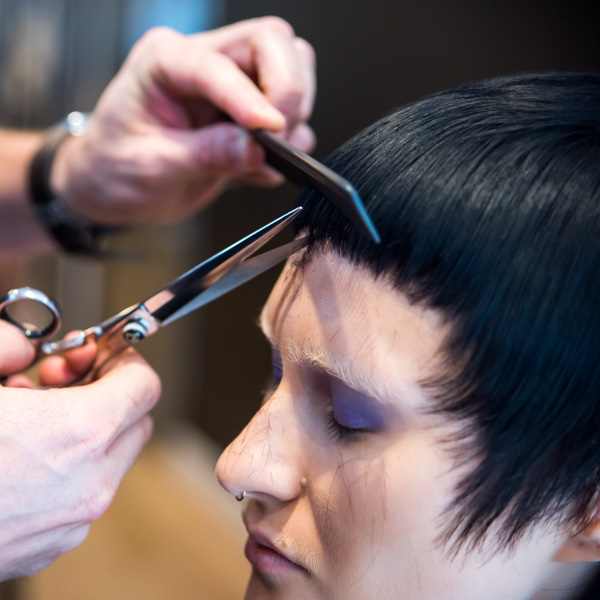Last updated: March 27, 2018
4 Technical Cutting Tips For Every Haircut
Whether blunt-cutting or point-cutting, dry-cutting or wet-cutting, the technique, sectioning and products used all make a difference when it comes to creating a great haircut. While onsite at the Empower You event with Ulta Beauty, Artistic Pro Team Member Carmody Homan shared some of his go-to tips for cutting hair behind the chair.
Blunt-Cutting vs. Point-Cutting
- The technique used will create different end results in the hair—blunt-cutting creates a smoother, cleaner effect and point-cutting will create more texture.
- When you want the hair to lay flatter, use a blunt-cutting technique.
- When you want the hair to have more swing or look more piecey, use a point-cutting technique.
Cutting Wet vs. Cutting Dry
- Typically, Carmody avoids dry-cutting. Instead, he starts the cut wet and works while it dries to get a better read on the hair.
- “If I were to dry-cut, I’d really have to go in and blow-dry the hair smooth, then flat iron it out—taking it out of its original state. If I am cutting wet, I can put the product in first, create clean sections and then organically watch how the hair responds,” says Carmody.
- Working this way allows Carmody to read how the hair falls in all environments—wet, half wet, dry—and from there, he can detail the finishing touches.
The Sectioning and Products Used
- Use a cutting lotion! It allows you to create super-clean sections, and using water alone won’t get the job done.
- Carmody likes Redken Outshine 01 because it’s not heavy and doesn’t get too sticky or hard. He applies it only once at the beginning of the cut and then sprays the hair with water as needed.
The Right Cut For The Right Face
- Any client can wear any haircut, but the hairdresser needs to know how to tweak it for their face shape.
- “For example, if a client wants a round fringe and she has a tiny face, you would probably cut it blunt, but you could also elevate it out so that it’s a little heavier, longer and has more swing to make it look really good on her face,” says Carmody.
- Study face shapes—know what cuts work best on what faces and how to alter them depending on the client in your chair.
Watch this quick clip on Carmody’s textured crop!
Get more cutting tips, plus styling and coloring tricks from the Ulta Beauty team!
More from
Ulta Beauty
-
Hair Color
The Bubble Technique: 5 Tips To Create Rainbow Hair Color
-
BTC Hair Trend Report
The Biggest Haircut Trends of 2024
-
Business
New To Budgeting & Investing? Start Here!
-
Business
The Ins & Outs Of Assisting: How To Be & Choose The Right Hair Assistant
-
Curly
Curly Consultation & Haircutting: Watch The Full Tutorial!
-
News
How Maui Hairdressers Are Rebuilding Post-Lahaina Fires
-
Business
How To Make 6 Figures From Stylists Who Actually DID IT
-
BTC Events
AI, Mental Health & Social Media: 7 Business Tips You Can’t Live Without
-
Business
6 Saving & Investing Tips To Grow Your Profit
-
Facebook Lives
Volume Guaranteed: Try This Layering Technique For Fine Hair
-
Bobs
The Biggest Haircut Trends of Summer 2023
-
Industry News
Vernon François Joins Ulta Beauty Pro Team of Industry-Leading Artists & Educators
-
Industry News
6 Award-Winning Hairstylists Join the Ulta Beauty Design Team
-
BTC Hair Trend Report
2023 Hairstyling: 11 Trends You Need To Know
-
BTC Hair Trend Report
2023’s Biggest Haircut Trends
-
Business
5 Steps You Must Take To Build A Strong Salon Culture
-
Beachwaves
6 Tips For Faux Blowouts & Effortless Waves
-
Blonde
The Biggest Hair Color Trends Of Winter 2023
-
Accessories
15 Styling Trends That Will Be Everywhere in Winter 2023
-
Balayage
5 Tips To Upgrade Your Cutting, Blonding & Styling Techniques
-
#ONESHOT HAIR AWARDS
Modern Art
-
BTC University
Dear Stylists, 4 Smart Ways To Protect Your Income
-
Facebook Lives
25-Minute Butterfly Layers Cut & Style
-
Business
Client Retention Checklist: 7 Ways To Keep Them Coming Back








